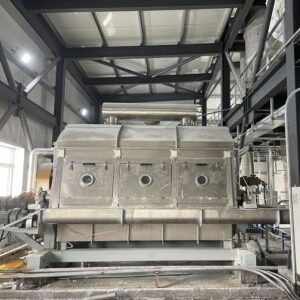An experimental spray dryer is a laboratory-scale device used to convert liquid solutions, emulsions, or suspensions into dry powder form. This process is achieved by atomizing the liquid feed into a fine mist and then exposing it to a hot drying gas, typically air. The rapid evaporation of the solvent results in the formation of fine, dry particles. Experimental spray dryers are essential tools in research and development, allowing scientists to test and optimize spray drying processes before scaling up to industrial production.
Key Features and Components
- Atomizer: The heart of the spray dryer, responsible for breaking down the liquid feed into fine droplets. Common types include rotary atomizers and nozzle atomizers (either pressure or pneumatic).
- Drying Chamber: A cylindrical or conical chamber where the atomized droplets come into contact with the hot drying gas, leading to rapid solvent evaporation.
- Heat Source: Typically, a heating element or heat exchanger that warms the drying gas to the desired temperature.
- Cyclone Separator: A component that separates the dry particles from the exhaust air, collecting the powder for further analysis or use.
- Control System: An integrated system for controlling temperature, airflow, and feed rate, allowing precise adjustment of the drying parameters.
- Sample Collection: Containers or chambers designed to collect the final dry powder product.
Applications
- Pharmaceuticals: Developing stable and effective drug formulations.
- Food and Beverage: Creating powdered food ingredients, flavors, and additives.
- Chemicals: Producing fine chemical powders for various applications.
- Materials Science: Studying the properties of new materials in powder form.
- Biotechnology: Drying sensitive biological materials, such as enzymes and probiotics.
Benefits
- Scalability: Provides insights and data that can be scaled up to industrial spray drying processes.
- Flexibility: Capable of handling a wide range of feed materials and producing various particle sizes.
- Efficiency: Rapid drying process with high yield and low product loss.
- Precision: Fine control over drying parameters to achieve the desired product characteristics.
- Versatility: Suitable for drying heat-sensitive materials without degradation.
Technical Specifications
- Feed Flow Rate: Adjustable to accommodate different viscosities and concentrations.
- Drying Temperature Range: Typically between 40°C to 300°C, depending on the material and application.
- Particle Size Range: Usually from a few microns to several hundred microns.
- Capacity: Laboratory models typically handle small batches, from a few milliliters to several liters per hour.
Usage Instructions
- Preparation: Prepare the liquid feed by ensuring it is homogeneous and free of large particulates.
- Setup: Configure the spray dryer by setting the desired parameters such as temperature, airflow, and feed rate.
- Operation: Start the spray drying process by introducing the liquid feed into the atomizer and initiating the drying cycle.
- Monitoring: Continuously monitor the process to ensure consistent drying and optimal product quality.
- Collection: Collect the dried powder from the cyclone separator and other collection points.
- Cleaning: Thoroughly clean the spray dryer components to prevent cross-contamination between different batches.




Reviews
There are no reviews yet.